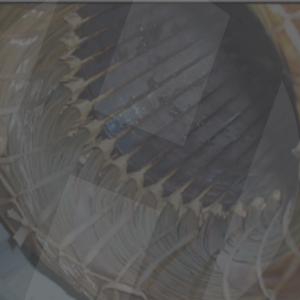Why Motors Fail: Part 1 – The Top 5 Failure Modes for AC and DC Motors
June 11, 2025
If you’ve ever had a motor go down unexpectedly, you know the impact can be immediate and expensive. Now, what if we told you most motor failures are preventable?
At HECO, we’ve analyzed three years of electric motor failure data across 240 clients in steel, paper, chemical, power, mining, plastics, and other industrial sectors. The results are eye-opening, especially when you realize many of the failures could have been avoided with the right maintenance strategy and data insights.
In this series, we’ll share the most common types of motor failures found in our TracRat Equipment Management software and provide actionable insights you can take to avoid motor downtime.
Motor Failure Trends You Should Know
In our analysis of the most common electric motor failures across all of our data, we decided to categorize the failures based on the type of electric motor and the type of failures.
Due to the differences in how AC and DC motors operate, we split the failures into the top five mechanical failures for both AC and DC motors and the top five electrical failures for each type of motor as well.
An interesting finding was that of the total motor failures analyzed across both AC and DC motors, nearly 56% of the motor failures were mechanical. Understanding these failure modes will help maintenance teams take more targeted action and avoid costly downtime.
The top mechanical failure modes for AC and DC motors were nearly identical. The shared failures included:
- Bearing failure due to lack of lubrication.
- Bearing failure as a result of over-lubrication.
- Bearing failure caused by shaft voltage and currents (often tied to VFD usage).
- Out-of-tolerance mechanical fits.
- Misalignment.
Top electrical failure modes for AC motors included:
- Winding failure due to overload.
- Winding failure as a result of overheating including blocked ventilation.
- Insulation deterioration and low resistance.
- Grounded windings from moisture or contaminants.
- Phase imbalance or single phasing.
For DC motors, the top electrical failure modes included:
- Commutator wear.
- Brush holder issues as a result of grounding or spring tension.
- Brush holder issues as a result of length, shunts, or the wrong grade.
- Overload due to stalling.
- Grounded fields and interpoles.
The data TracRat provided matches findings from the Electrical Apparatus Service Association (EASA) and the Institute of Electrical and Electronics Engineers (IEEE).
Collectively, the data showed that bearings were involved in more than 51% of issues. That statistic points to the need for all bearings, regardless of type, to be maintained and correctly relubricated on a regular basis. Specific timing consideration should include bearing size, equipment run time, and how the motor is coupled to the driven application.
What This Means for Your Facility
The numbers in our failure study were pulled directly from what our technicians found when inspecting motors in our shop. While these observations don’t always reveal the root cause, they are an invaluable starting point for increasing reliability.
In short, motor failures aren’t random. They are tied to repeatable patterns and system-wide conditions. Most motors don’t fail because of a single catastrophic event. They fail from compounding issues such as a misapplied motor, poor storage conditions, or something as simple as the wrong grease type.
At HECO, we often see a disconnect between what’s happening on the floor and what shows up in our repair shop. That’s why it’s important to bridge those gaps with the right data and insights before failure occurs.
Gathering data for your application, plant, and corporation as a whole and implementing a thorough equipment management system can help you identify the most common failure modes, substantiate causes, and predict and avoid them as well as knowing what spares you have on hand and their history.
We suggest utilizing a system such as TracRat to help identify your critical applications and spares as a means to approach reliability and inventory simultaneously.
If you’ve done business with HECO, your historical motor repair data already lives inside TracRat. You may have more insights at your fingertips than you realize.
All Systems Go
In Part 2 of this series, we’ll look at lubrication issues, misalignment, and how modern AC and DC motors are more vulnerable to shaft voltage than ever before, as well as offer action items you can take to avoid motor failures.
Need help understanding your own failure patterns? Contact us to learn about TracRat access or schedule a plant-wide motor survey. HECO is dedicated to helping you improve your equipment’s reliability and efficiency.
Posted in Equipment Management, Repair
